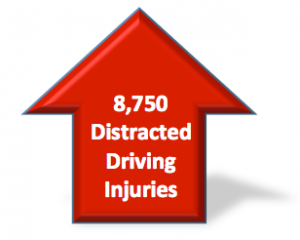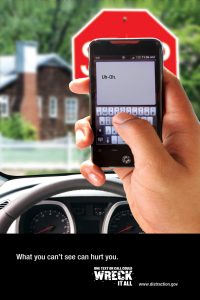Distracted Driving Accidents Take A Toll on Oregonians
Distracted Driving Accidents Significantly Increase in Oregon
Distracted driving accidents caused by texting or using a hand-held cell phone while driving in Oregon, are significantly increasing, so much so that Oregon State Police now estimate that 25% of Oregon car accident injuries involve distracted driving. If you are involved in a distracted driving car accident, you can be held liable for your negligent actions, and responsible for any corresponding damages that you cause. In spite of the obvious correlation between using hand-held cell phones and car, bicycle or pedestrian accidents, Oregonians continue to believe they will not fall victim to the 5-second distraction caused by texting or fumbling for a hand-held device. The most recent statistics certainly prove this is not the case.
- According to the National Highway Transportation Safety Administration (the guys that monitor and measure our driving habits), cell phone usage while driving is increasing to historic levels. NHTSA estimates, during every moment of the day, 660,000 U.S. drivers are using their cell phones while driving[1], and 6.5% of these drivers are either texting or manipulating hand held devices[2]. That means 42,900 drivers are driving distracted and in violation of the law, every moment of the day.
- Oregon drivers are involved in approximately 51,000 crashes annually, which seriously injure more than 35,000 drivers, passengers, pedestrians, and cyclists.[3] It is estimated that 20-25% of these injury accidents now involve distracted driving … which can be more significant and dangerous than drunk driving.
- Oregon’s most recent increases in vehicle accident deaths, 11% in 2014 and another 27% in 2015, is being attributed, in part, to significant increases in cell phone usage and distracted driving. According to the National Safety Council, this moves Oregon up into second place for states with the highest increases in fatalities.[4]
Recent actions to reduce the chances that you will be involved in a distracted driving accident
- Increased enforcement and fines. Fines for distracted driving have increased several times since the 2010 law was enacted, and now at $500 per violation, makes Oregon one of the highest distracted driving fines in the nation[5]. To change distracted driving behaviors, law enforcement has stepped up their enforcement, by adding 40 unmarked patrol cars, focused on distracted driving and speeding violators. These actions, along with a priority focus on distracted driving violators have produced an almost 40% increase in Oregon distracted driving traffic stops[6].
- Increased distracted driving awareness and safety campaigns. On a daily basis, we experience the effects of drivers on their cell phones checking text messages or trying to respond to the latest “ding” as if that is more important than driving safely. To combat these behaviors, distracted driving awareness and safety campaigns, similar to those used to create public awareness about drunk driving, are being used. It took many years for campaigns like Mothers Against Drunk Driving to become effective and create the awareness of how devastating and life changing these actions can be. If you have any doubt, simply Google “distracted driving videos” and watch any of the thousands of videos posted documenting stolen lives. So why are we in such denial about distracted driving? Perhaps we don’t associate this behavior as being wrong or dangerous until something happens to create the over-riding awareness and fear. With this logic we will educate about 430,000 people every year; the number of drivers who are annually injured in distracted driving accidents.
430,000 Drivers are Seriously Injured Every Year in Distracted Driving Accidents
- Use of technology to determine if a cell phone was used at the time of a car accident – the “Textalyzer.” What the Breathalyzer did for drunk driving, the Textalyzer may do for distracted driving car accidents. While the technology is still going through the legal and law enforcement adoption phases, it holds significant promise as a key tool in the routine detection and enforcement of distracted driving laws. The technology can be used at an accident scene to determine if the drivers were using their cell phones in a prohibited manner, such as texting or using the device in a hand-held manner. Failure to submit to the test would be cause for further action against the driver, such as suspension of their driver’s license. It also could weigh heavily on the opinions of juries in the event the case was litigated in a civil action to recover damages for the negligent driver’s conduct. In addition, insurance companies will almost certainly react in classifying such confirmed behavior as “high risk”, and require an SR-22 certificate be filed on your behalf before your license is reinstated. While the cost of filing an SR-22 certificate is very modest (less than $50), the associated changes in your auto insurance cost will likely increase $50 to $500 per MONTH.
What the Breathalyzer did for drunk driving, the “Textalyzer” may do for distracted driving car accidents.
Distracted Driving Accidents Can Lead to Claims for Punitive Damages
In the typical car crash case, the victim who is injured can pursue their medical bills, property damages and lost wages from the negligent driver. These types of economic losses are known as economic damages. The injured victim can also seek compensation for pain & suffering, inconvenience, interference with their ordinary and usual activites, emotional distress and loss of enjoyment of life. These types of physical, mental and emotional harms are known as non-economic damages. Economic and non-economic damages are designed to compensate the victim.
In certain distracted driving accident cases, however, when the at-fault driver’s conduct is reckless (which is worse than negligence), the victim can pursue a claim for punitive damages. Punitive damages are designed to punish bad behavior and deter other drivers from acting the same way. Drunk driving is reckless behavior because the driver knows, or should know, that getting into the car and driving while he/she is intoxicated could likely lead to a crash that causes property damage, injuries or death. Similarly, distracted driving can be reckless conduct. Any person who is texting or focusing on a hand held device instead of the road knows, or should know, that they are doing something that is dangerous. Pursuing punitive damages in distracted driving accident cases will typically lead to an increase in the value of the case, either by settlement or at trial.
Contact Portland Auto Accident Lawyer Travis Mayor

If you or someone you know has been injured as a result of another person’s conduct, and you are looking for a skilled attorney to lead you through the insurance roadblocks, please call today for a free and confidential case evaluation. Local (503) 610-0005 and Toll free 1-800-949-1481 or email travis@mayorlaw.com.
For additional information about distracted driving accidents, insurance, and maximizing your financial recovery, I recommend the following articles on my Blog:
- Distracted Driving in Oregon: The Dangers of Technological Distractions
- Portland Distracted Driving Accident Lawyer
- Oregon Distracted Driving FAQs
[1] Source: http://www-nrd.nhtsa.dot.gov/Pubs/811719.pdf.
[2] Source: http://www-nrd.nhtsa.dot.gov/Pubs/812197.pdf.
[3] Source: https://www.oregon.gov/ODOT/TD/TDATA/car/docs/Crash_Summary.pdf.
[4] Source: http://www.nsc.org/NewsDocuments/2016/mv-fatality-report-1215.pdf.
[5] Source: https://www.oregon.gov/ODOT/Documents/Distracted%20Driving%20An%20Epidemic.pdf.
[6] Source: http://www.oregonlive.com/commuting/index.ssf/2016/04/oregon_state_police_using_40_u.html.


